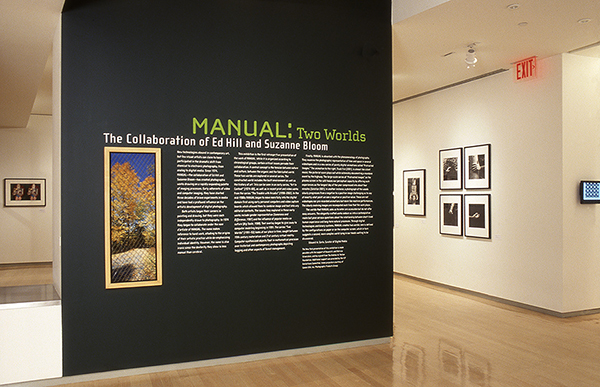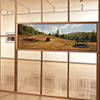ICP

above: title wall, retrospective exhibition, International Center of Photography, 2002
MANUAL: Two Worlds (The Collaboration of Ed Hill and Suzanne Bloom)
International Center of Photography, June 28 — September 1, 2002
Title wall overview text by Edward W. Earle, Curator of Digital Media:
New technologies abound in contemporary art, but few visual artists can claim to have participated in the dramatic shift from chemical to electronic photography, from analog to digital media. Since 1974, MANUAL—the collaboration of Ed Hill and Suzanne Bloom—has created photographic works drawing on a rapidly expanding palette of imaging practices. Early adherents of video and computer imaging, they have charted three decades of brave experiments in media and have had a profound influence on the artistic development of digital photography.
Both artists began their careers in painting and drawing, but they were each independently drawn to photography. In 1974 they began to collaborate under the nom d’artiste of MANUAL, alluding to the origins of their artistic practice while de-emphasizing individual identity. However, the name is also ironic since the dexterity they show is less manual than cerebral.
This exhibition is the first retrospective presentation of the work of MANUAL. While it is organized according to chronological groups, certain critical issues pervade their collaboration. A central concept is the tension between nature and culture, between the organic and the fabricated world. These two worlds are explored in several series. The constructed world includes the built environment as well as the history of art. This can be seen in an early series, Art and Context (1972-1980), as well as in recent ptint and video works from the series The Trouble with Arcadia (1998-2002). In the mid-1980s, MANUAL began to move more fully into the digital domain, first using early personal computers and video capture boards which allowed them to combine image and text into wry editorial contexts. The issues they explore in these early works include gender representations (Sameness and Difference, 1987) and the influence of popular media on culture (Big Taste, 1988). Text overlay began to give way to computer modeling beginning in 1991. The series Two Worlds (1991-93) looks at our place in time, caught between 19th century materialism and 21st century virtual reality. Computer-synthesized objects float in mathematical precision over historical and contemporary photographs depicting logging and other aspects of forest management.
Finally, MANUAL, is absorbed with the phenomenology of photography. They examine the photographic representation of time and space in several videotapes and a new series of purely digital animations called Protracted Images. The animation … Truck Fire (2001), is almost like silent music: the pictorial score plays out while ostensibly documenting a mundane event by the highway. The large-scale series of Protracted Images…teases our perceptual capacity by offering such experiences as the longest day of the year compressed into about four minutes (Solstice, 2001). In another instance, a photograph of the woods slowly progresses from a negative to a positive image challenging us to say at exactly what point we see a negative or positive value. These are not videotapes nor pre-recorded animations, but more like machine performances. The slowly evolving images are recomputed each time that the work plays.
The worlds that MANUAL asks us to enter are accessible, but do not offer easy answers. The elegantly crafted works seduce us into a contemplative realm, but pose serious questions about short-lived human experience and long-term natural processes. Through digital technologies and binary systems, MANUAL creates two worlds: one is defined by the configurations on paper or on the computer screen, which in turn suggests a second more complex world lying in our heads waiting to be discovered.
Click image below to link to 17 installation shots from Two Worlds (The Collaboration of Ed Hill and Suzanne Bloom) arranged in gallery groups of one to three images each.
 installation shots
installation shots